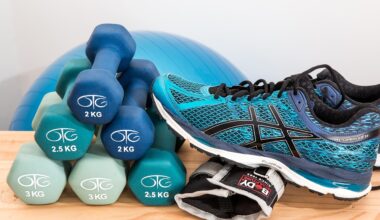The Role of Flexibility in Youth Athlete Conditioning
Flexibility plays a crucial role in the athletic development of young athletes and is essential for their overall conditioning. As youth engage in sports, their bodies are growing and changing, making flexibility training crucial for performance enhancement. A flexible athlete can perform techniques more effectively, reducing the risk of injury during competition or training. Poor flexibility can lead to muscle strains, joint problems, and decreased range of motion, which can hinder performance. It’s essential for coaches and parents to incorporate flexibility routines into youth training sessions. These routines should include dynamic stretches before workouts and static stretches afterward. Proper implementation can lead to improved muscle elasticity and joint health. Young athletes participating in sports like gymnastics, soccer, or martial arts can greatly benefit from flexibility training. Ultimately, flexibility not only aids in physical development but also helps foster a deeper understanding of body mechanics among young athletes.
Incorporating flexibility training into youth athletes’ routines can be accomplished in various enjoyable ways. Activities like yoga, dance, and specific stretching exercises are fantastic options. These methods help develop flexibility while also keeping the young participants engaged. Coaches can also design sport-specific flexibility drills that emphasize the muscles used in the respective sport. For instance, soccer players benefit from hip and hamstring stretches, while swimmers may focus on shoulder flexibility. Teaching young athletes the importance of listening to their bodies during flexibility training is equally vital. They should understand when to push their limits and when to ease off to prevent injuries. Moreover, making flexibility exercises a fun part of warm-up and cool-down routines encourages continued participation. When youth athletes see tangible improvements in their abilities due to increased flexibility, their motivation will soar. By integrating these practices into the conditioning programs, coaches and trainers can create well-rounded athletes capable of performing their best across various athletic domains.
Benefits of Flexibility in Performance
The benefits of flexibility extend beyond injury prevention; they directly enhance athletic performance. When young athletes engage regularly in flexibility training, they often notice improved agility and speed. Increased range of motion allows for better performance in skills requiring explosive movements, like jumping or sprinting. For example, a flexible lower body can result in a more powerful stride in track events. Furthermore, flexibility contributes to better balance and coordination, essential traits for any athlete. Better coordination can lead to more effective execution of techniques and strategies, giving young athletes a competitive edge. Research highlights that athletes who prioritize flexibility can recover faster from intense training sessions. Enhanced recovery times help maintain a consistent training schedule alongside improved performance. A holistic approach to conditioning that includes flexibility training can significantly impact young athletes as they transition through various competitive levels. Encouraging young athletes to embrace flexibility training promotes body awareness and fosters a lifelong appreciation for physical fitness and health.
Progress measurement in flexibility training is crucial. Coaches and trainers should establish benchmarks to assess improvement over time. Simple testing methods, such as sit-and-reach tests, can provide valuable insights into an individual athlete’s progress. Regular assessments not only motivate young athletes but also help determine appropriate adjustments to their flexibility regimen. It’s essential to record these metrics systematically to show measurable improvement. This documentation can foster a positive mindset, as young athletes visualize tangible progress in their flexibility levels. Additionally, incorporating feedback loops enhances these training sessions, allowing athletes to understand their strengths and areas needing improvement. By keeping athletes informed about their progress, coaches can boost confidence and maintain engagement during training sessions. This practice aligns with the concept of setting SMART goals—Specific, Measurable, Achievable, Relevant, and Time-bound—to cultivate total athlete conditioning. As athletes become more aware of their strengths and weaknesses, they will enhance their training efforts and commitment to conditioning as a whole.
Common Mistakes in Flexibility Training
Despite the numerous benefits, many young athletes and their coaches often make common mistakes when incorporating flexibility training. One significant error is neglecting to warm up before stretching. Warm muscles are more pliable and can be stretched safely, while cold muscles are vulnerable to injury. Educating athletes on the importance of proper warm-ups is critical for effective conditioning. Additionally, some athletes may push themselves too hard during stretching, leading to strains and tears. Emphasizing that flexibility training should be gradual encourages safety and effectiveness in improving flexibility. Another mistake is skipping stretching altogether, which can lead to subpar athletic performance or injury. Regular reminders and discussions around the role of flexibility in achieving athletic goals can help reinforce its importance. Furthermore, not varying flexibility routines can lead to stagnation in progress. Incorporating diverse stretching techniques and exercises keeps athletes engaged and promotes balanced development. When coaches recognize and correct these mistakes, they can improve the overall effectiveness of flexibility among their athletes, leading to enhanced performance and reduced injury rates.
Flexibility can also be influenced by various factors, including the age and physical development of youth athletes. Understanding these factors helps tailor a flexibility program that meets individual athletes’ needs. For instance, younger children may naturally have more flexible bodies due to the elasticity of their growing muscles and connective tissues. However, as adolescents, their flexibility may diminish if not appropriately maintained. Coaches need to adapt their training accordingly, focusing on flexibility protocols that cater to different stages of physical development. Additionally, environmental factors such as hydration and nutrition can impact flexibility. Adequate hydration ensures that muscles remain pliable, while proper nutrition fuels recovery. Young athletes should be encouraged to develop healthy habits surrounding these areas to maximize their flexibility training. Including flexibility exercises in their daily routine will not only aid performance but also establish lifelong habits that emphasize well-being and fitness. Thus, recognizing these varying factors in flexibility helps athletes effectively navigate their conditioning journey and achieve the best possible outcomes.
The Future of Flexibility Training
The future of flexibility training for youth athletes is expected to evolve alongside advancements in sports science and training methodologies. Innovative techniques such as virtual reality and wearable technology are emerging, potentially transforming how flexibility programs are designed and implemented. Virtual reality can engage young athletes in immersive stretching experiences, making training enjoyable and impactful. Wearable technology will provide real-time feedback on an athlete’s stretching techniques and performance metrics, helping refine their routines. As research continues to uncover the broader impacts of flexibility on athletic performance and recovery, growth in holistic training approaches will likely follow. More emphasis may be placed on yoga, pilates, and functional movement patterns due to their effectiveness in enhancing flexibility while promoting overall health. Such a comprehensive approach will aid in fostering athlete longevity and success while minimizing potential injury risks. By embracing these future trends, coaches can better equip young athletes with the essential skills required for continued athletic development. Encouraging flexible training methods lays the foundation for careers that may lead them to the highest levels of competitive sports.
In summary, flexibility is a vital component of youth athlete conditioning that promotes performance, safety, and long-term athletic development. The benefits are plentiful, encouraging young athletes to engage regularly in flexibility exercises, whether through structured programs or integrated routines within their sports practices. Coaches play an essential role in fostering understanding and implementation amongst athletes, emphasizing that flexibility training is not merely an ancillary component but rather a critical aspect of their development. The future of training and conditioning will undoubtedly continue to evolve, with flexibility being a major focus. As innovative techniques emerge and research sheds light on its extensive impacts, flexibility training will remain indispensable in shaping well-rounded athletes. From preventing injuries to enhancing performance and resilience, flexibility training holds paramount significance in youth sports. For coaches, educators, and parents, fostering a culture that values flexibility among young athletes is necessary for creating successful, athletic careers throughout their lives. The ultimate goal should be nurturing a passion for physical fitness, ensuring athletes understand their bodies while optimizing performance and health.


